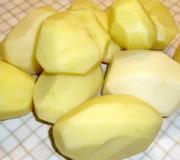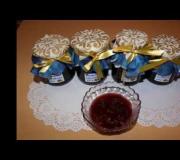Churchkhela made from apple juice. How to make churchkhela. How to make churchkhela - preparation
This exotic sweet with an unpronounceable name is easy to prepare at home: a minimum of available products and you have “sweet greetings from Georgia” on your table.
The first thing you need are nuts for the filling. Traditionally, hazelnuts, almonds and are used. The filling of churchkhela can be either homogeneous - one type of nut is used, or mixed - a nut mix, to which you can also add raisins, pumpkin seeds, and prunes. Prepare a strong cotton thread on which you will string the nuts and a thick needle. The thread for a churchkhela measuring 25 cm should be 10 - 15 cm longer; at the remaining end of the thread you need to make a loop, on which the churchkhela will later be hung to dry. Decide in advance where to dry the churchkhela until it is completely ready (you will have to wait 5-7 days). You can adapt a rolling pin for these purposes, put loops on it and fix it so that the “walnut threads” hang freely. Make sure you have baking paper (or a paper towel) on which the dripping juice will drip.
Now you can start preparing grape jelly - pelamushi or tatara, into which the nut threads will be dipped. Typically, natural white or red grape juice and corn flour are used to prepare pelamushi, but the original ingredients can be replaced, for example, using wheat flour instead of corn flour. It’s easy to get freshly squeezed grape juice at home: buy it and run it through a juicer or puree the berries in a blender and squeeze. In extreme cases, natural juice can be replaced with packaged juice.
Churchkhela cooked with grape juice has a pleasant chocolate color. Departing from the “canonical” recipe, you can use juices from other fruits and berries. Churchkhela made from pomegranate juice is red, from apple juice it is amber, and from apricot juice it is golden.
For pelamushi for 350 g of nuts you will need 2 liters of grape juice, 200 g of flour. If the grape juice is not very sweet, add honey.
Preparation. Pour off half the grape juice and set aside. Bring the remaining grape juice to a boil and cook for 10-15 minutes. Add flour to the reserved half of the juice and mix thoroughly so that there are no lumps. Pour the flour mixture little by little into the boiling grape juice, cook over low heat for 15 - 20 minutes, remembering to stir.
Dip the thread with nuts into grape jelly, using a wooden spatula, thoroughly soak the churchkhela. Hang the sausages to dry with baking paper underneath them. Once they are a little dry (after about 20 minutes), dip them in the pelamushi again. Repeat the procedure until the churchkhela reaches the desired thickness. Hang the churchkhela to dry.
Advice! If you have prepared churchkhela, and you still have “jelly” (pelamushi), do not rush to throw it away! “Kissel” is a completely independent dish, to which you can add nut crumbs and serve for dessert.
Churchkhela is a very tasty long Georgian sweet made from nuts and nougat made from grape juice. Traditionally, they are prepared in August-September, when the joint harvest of walnuts and grapes takes place - for dessert it is best to use walnut kernels of milky ripeness, as they are easier to put on a needle. I prepared churchkhela in March - from the dried kernels that I had leftover, and I want to say that it is best to soak the dried kernels for 20 minutes in water before threading them on a needle - they will crumble less.
Since in our age it is very easy to find store-bought grape juice, but it is difficult to find freshly squeezed juice (like mine), you can buy such a drink in the supermarket. By the way, using light grape juice, you can color it with food dyes in different colors and at the same time get multi-colored long churchkhela candies.
The most important point: remember that flour is not added to hot liquid, otherwise you will get a thick jelly with flour lumps! Pour flour into cold liquid only! I made churchkhela for the first time, so I used 500 ml of grape juice for 3 long braids with nuts.
Prepare the indicated ingredients.
Using a thin needle, string the walnut kernels onto the threads, leaving a little space on top, as the churchkhelas should hang. You can string both pieces of kernels and whole kernels.

Pour grape juice into a saucepan, saucepan or cauldron, pour flour into the container and immediately beat everything with a whisk, mixer or puree with an immersion blender until the liquid becomes homogeneous.

Place a container with a homogeneous liquid on the stove, turning on minimal heat. I don’t see the point in evaporating grape juice for a long time so that it becomes concentrated - you can just add granulated sugar to taste.

Add sugar, stir thoroughly in the drink and cook until thick and thick. The mass should resemble thick jelly. Leave for 10-15 minutes to cool.

Hang the nut sausages on some device - for me it’s a hanger for kitchen appliances.
There is also the option of pouring the jelly mass into a wide rectangular basin or mold - then the sausages are dipped into it and hung to drain the jelly mass.

I find it more convenient to pour the mixture onto suspended nut sausages. Use a tablespoon to scoop a little mixture and pour it directly onto the top row of kernels. Pour very slowly, adjusting and shaping it with your finger. Apply one layer and leave for 20-30 minutes to cool, then apply the second layer in the same way. In the photo I have two layers of grape jelly on the kernels. The more layers of nougat, the longer the churchkhela will dry (that's why I stopped at two). In this form, take the sausages and sweets into a ventilated room, preferably at room temperature. Usually, in the warm autumn season, sweets are air-dried and slightly dried in the sun, but I left them in the kitchen near the radiator at +24.

The Churchkhelas finally dried out and withered on the fourth day of drying. The readiness of the sweets is determined by the fact that they do not stick to your hands - the nougat should become like rubber when squeezed. Now you can try the sweetness - it’s really incredibly tasty and not cloying!


Enjoy your tea party with sweets.

There are few tasty and healthy desserts that can retain their taste for months. Churchkhela or " sujuk from walnuts" contains ingredients available almost at any time of the year, and can compete with other recipes in ease of preparation. A centuries-old wonder from the east, it was often used by warriors on long campaigns to reinforce their strength. It is an integral part of local feasts and feasts.
How to make churchkhela - necessary ingredients
- Fresh grapes – 1.5 – 3 kg. Sweet varieties with the lowest seed content are suitable, such as Isabella, Moldova, out of season; you can use store-bought or home-canned juice 1 - 2 liters.
- Nuts - in the classic version, walnuts and hazelnuts are used, there are different ratios, for example, 70% to 30%, nothing prevents you from changing the proportions. Total weight 150 - 200 g per liter of juice.
- Sifted wheat or corn flour – 100 – 125 g per 1 liter of juice.
- A thick needle and several meters of strong cotton thread, a thimble.
How to make churchkhela - preparation
Nuts
- If you want to deviate from the canonical recipe, you can add pumpkin seeds, raisins, apricot kernels or small prunes to the nuts. Also, pomegranate juice will give the candies a red color, apple juice – amber, and apricot juice – yellow.
- The cooking process itself begins with preparing a place for drying churchkhela. The average length of the threads is 30 - 40 cm. Do not forget that juice will drip at first, so prepare baking paper or baking sheets so as not to spoil the lower surfaces. If it is placed outdoors, you will need gauze covers to protect it from insects.
- The next step begins with lightly frying the nuts in an empty frying pan for 3-5 minutes. The walnut is divided into halves and, if it is very large, then into quarters.
- Now you need to string the nuts onto a thread, piercing them with a needle, creating a row 15–25 cm long. Also leaving an indent of 5–10 cm on each edge of the sausage. A knot is tied at one edge or a toothpick is tied so that the nuts do not move out. On the other there is a loop for attaching threads in a vertical position.


Cooking pelamushi
- The grapes are washed and placed in the juicer. If this technique is not available, a blender will come in handy, after which the pulp is rubbed through a sieve or squeezed through cheesecloth. All the juice, except for 200 - 300 g of glass, is poured into a saucepan and simmered over low heat for 15-25 minutes. The remaining portion goes into the bowl along with the flour and is mixed until smooth.
- After the juice has boiled, you can cook for a couple more minutes. Add the liquid and flour contents in a small stream, remembering to stir vigorously with a wooden spoon. There is no need to rush, this is one of the most important stages. Rushing or lack of stirring will lead to lumps, which can have a detrimental effect on the result.
- The juice is boiled for 15 – 20 minutes. until jelly-like. Stir once every couple of minutes. It is also worth tasting the juice for sweetness; if it is a little sour, add honey or sugar. If the juice has thickened enough and holds on a spoon, then it is cooled on the stove to 50 ° C.


Churchkhela – final stage
- Prepared threads with nuts are dipped in pelamush using a spoon for 3-5 minutes. This is done so that the ends of the threads do not fall into the dishes. Keep the sweets over the pan so that the excess drips off. If the nuts are completely exposed, it means the jelly was not thick enough and next time you need to add more flour. Then the sweets are hung out to dry for 20 minutes. The procedure is repeated until the nuts are covered by 2 cm (or a little more) pelamushyu.
- The remaining jelly and nuts can be mixed, and then poured into small molds and put in the oven for 10-20 minutes. You will get delicious candies. The very same pelamush It takes 4-7 days to dry in the apartment. You can speed up the process and expose it to the sun for 2 days, but this will dry out the product more.
- Churchkhela is almost ready to eat. According to tradition, they are placed in boxes and hidden in dark, dry places for several months for final soaking of the nuts.


As you can see from the example above, oriental wonders are not always difficult to prepare, or not available in terms of ingredients. But they certainly add great variety to the everyday dessert range. Also in the future, you can experiment with fillings and spices, which will finally add uniqueness to the product.
Churchkhela is a delicious national Georgian and Armenian delicacy made on a string. It turns out that the recipe for making churchkhela is quite simple, and you can make it yourself at home. It is usually made from walnuts, but almonds or hazelnuts can also be used. What always remains unchanged in this dish is the grape starchy jelly-like mass called Tatars. It is brewed from grape juice, sugar and flour. Making churchkhela is a simple and very interesting procedure, however, you will have to wait about a couple of weeks for the results. Let's look at recipes for making churchkhela.
Churchkhela at home
Ingredients:
- grape juice – 2 l;
- peeled walnuts – 1.5 tbsp;
- wheat flour – 250 g;
- honey – 0.5 tbsp.
Preparation
How to make churchkhela at home? To begin, carefully string the hazelnuts and walnut halves onto a strong, thick thread approximately 25 cm long using a large needle. We leave 6 cm of free thread on top and make a loop, from which we will then hang our delicacy.
Pour the remaining juice into a saucepan and begin to simmer until it boils over low heat. After boiling, add the juice and flour, carefully pouring in a thin stream, stirring continuously. Next, without stopping stirring, add honey. Boil the mixture to a consistency reminiscent of very thick jelly. Then remove the tatara from the heat and, stirring, cool to 50 degrees.
Now take the threads with nuts and completely immerse them in the prepared mass for about 2 minutes, so that the entire thread is covered with thick juice.
Dry the churchkhela in a dry, well-ventilated area. Be sure to place paper under the sweetness, because juice will drip at first. Determine the degree of readiness as the top layer dries, and the inside of the churchkhela should remain soft. After drying, transfer the treat to the box, alternating with parchment paper. The sweetness is completely ready after about 2-3 months, when the delicacy is completely dried out.
Armenian churchkhela
Ingredients:
- apple or apricot juice – 1 l;
- corn or wheat flour – 0.5 tbsp;
- almonds, walnuts, hazelnuts, dried fruits - to taste.
Preparation
How to cook churchkhela? Before preparing churchkhela, we thread nuts with any dried fruits (hazelnuts with pineapple or walnuts with kiwi) through threads.
Now let's move on to preparing the juice decoction. Pour the selected juice into a saucepan, put it on medium heat and, as soon as it boils, slowly add the pre-sifted flour, stirring everything lightly with a spoon. You can add a little cinnamon to taste or a vanilla pod to the juice before boiling.  As soon as our mixture takes on the consistency of thick jelly, carefully remove from heat and cool.
As soon as our mixture takes on the consistency of thick jelly, carefully remove from heat and cool.
Dip dried fruits and nuts strung on threads into the cooled mixture for about a minute. Next, take out and dry the churchkhela for 5 minutes, and then repeat this procedure two or three times to get a thick layer.
Carefully fasten the churchkhela to a thread and hang it to dry for about two weeks in a dry, well-ventilated place. Be sure to place paper under the sweets.
Well, while your churchkhela is drying, you can treat yourself to other delicacies, for example, or.
While vacationing in the south, many heard peddlers on the beach or traders at the bazaar loudly shouting: “Churchkhela!” Someone tried this delicacy, but others never dared to taste Georgian sweets, not knowing what churchkhela is. Meanwhile, this is a very healthy dessert made from nuts and fruit juice, although the high calorie content still makes you count the number of churchkhela sticks eaten.
General principlesIf you haven’t seen how this dessert is prepared in the Caucasus, and don’t know how and what to make churchkhela at home, just follow a few simple rules.
First: The basis of the delicacy is nuts. The classic version uses either walnuts or hazelnuts. However, cooking always gives room for imagination, so you can experiment, using peanuts, hazel, and other varieties of nuts as a basis, alternating them with each other and even “dilute” them with dried fruits: dried apricots, prunes, apricots.
Second: the necessary ingredient is juice, in the original grape juice. However, grapes do not grow everywhere, so you can make churchkhela from any juice. The main thing is that it should be freshly squeezed and thick enough. If the juice is not very sweet, you can add sugar or honey, but remember that sugar is added to boiling juice, and honey is added to cooled juice.
Third The required ingredient is flour. Traditionally, finely ground wheat flour is used, sifted and without impurities, but you can use oatmeal, corn, and rye flour - the main thing is that it must be ground very, very finely.
The recipe is traditional, the simplestThe easiest way to make it is traditional Georgian churchkhela, the recipe for which includes a minimum of ingredients.
Ingredients:
- juice from white table grapes – 3 l;
- finely ground premium white wheat flour – 3 cups (cup – about 150 g);
- peeled in halves – 1 kg.
Preparation
The most difficult thing in preparing churchkhela is stringing the nuts on a string so that they do not crumble. This should be done using a needle, which is threaded with a strong thread made of natural fiber - linen or cotton. Of course, we only use undyed thread. When the nuts are strung on strings (20-25 for each), we leave a free tail on each string, long enough to hang the churchkhela to dry. Divide the juice in half. We set half to cook on the fire, carefully dissolve the flour in the second, and stir with a whisk to prevent lumps. As half of the juice boils, slowly, stirring, pour in the second part - with flour. The mixture cooks and thickens quickly, so under no circumstances leave the stove or stop stirring. Turn off the thickened mixture and cool. Now the most interesting thing is how to cook churchkhela so that it turns out dense and smooth. To do this, dip the thread with nuts in our juice, lift it, wait for the residue to drain, and hang it for a couple of hours. Then we repeat bathing the nuts in juice. Drying churchkhela lasts 3-4 days. The place should be cool, well ventilated, and there should be no access for animals and insects. After a few days, we remove the treat and enjoy the viscous sweetness of the fruit concentrate and crunchy nuts. If you have prepared a lot of churchkhela, the question will arise of how to store churchkhela at home. If you leave it in the fresh air, the sticks may stick together, so we wrap each one with parchment or cling film and put it in the refrigerator.
Turn on your imaginationAn unusual delicacy - churchkhela with hazelnuts - is prepared in the same way, but you can get a little creative and make such a dessert that your guests will simply swallow their tongues.




